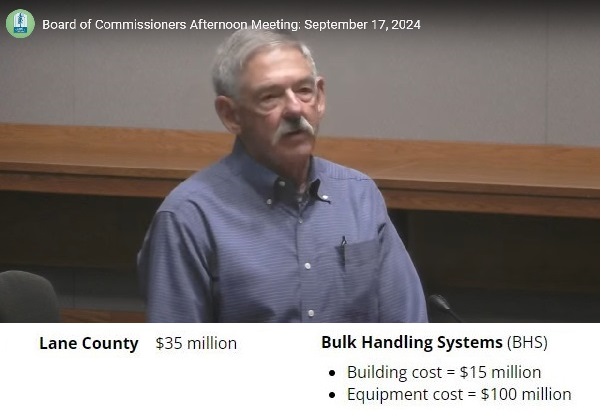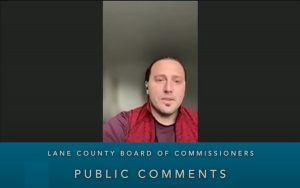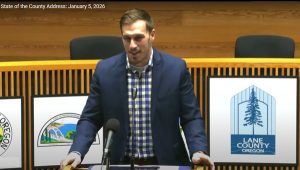CleanLane project draws more scrutiny, criticism
9 min read
The bitterness lingers. Lane County ‘broke up’ with EPUD after 40 years, choosing a partner offering to invest $115 million in Goshen.
Three county commissioners approved the IMERF (Integrated Materials and Energy Recovery Facility), despite testimony that 40,000 rural residents would pay more for electricity and garbage service.
An EPUD board member signed up for a recent public hearing. On Sept. 17:
[00:00:25] Commissioner Laurie Trieger: We have one person signed up and it is someone who has presented to this board before and again, public testimony I will now invite on the findings only and the proposed order which is for an alternative procurement process known as ‘Construction Manager General Contractor’ approach for soliciting for construction of a portion of the CleanLane Resource Recovery Facility.
[00:00:47] This is not time to give public comment on the project overall, but simply on this procedural matter of county staff seeking board approval to go with a different procurement model than is typical for capital construction. And so with that, I will ask the one gentleman who has signed up to give public comment, if he feels his remarks meet these parameters.
[00:01:09] Then I will invite Curt Offenbacher to the podium to give public comment
[00:01:14] Curt Offenbacher (Emerald People’s Utility District, board member, treasurer): I’ve been involved in this area since 1976 in construction. I know it inside and out. CMGC works? It doesn’t work. I’ve used that method and other methods. I’m not connected to any contractor. I have no bias. I’m well retired. I’m 76 years old, but I still have an interest in our community.
[00:01:35] So your staff cites the following reasons for CMGC. Reason 1: Increased ability to avoid delays and meet construction timelines. It’s not true. Your external funding is available once equipment fabrication begins, which can easily be started before the end of the year. What’s the rush?
[00:01:58] Number 2: Increased opportunity to reduce construction costs during design process. Not true. You awarded a $2.6 million contract to Bulk Handling Systems in January to provide 100% design services. Public Works stated on Aug. 20, design was 90% done. So what can a CMGC contribute to design at this point? Nothing. If it was 90% done Aug. 20, it sure as heck should be pushing 100% right now.
[00:02:36] Improved collaboration with, throughout design and construction process. That’s not true. Design is done, and this is a new site, it’s clean, and a simple pre-engineered metal building. Site coordination is the contractor’s responsibility under any method, regardless even if there is two different contracts on the same site. That’s the contractor’s responsibility.
[00:03:03] Then you’re asked to approve written findings: “It is unlikely the exemption will encourage favoritism.” This is the significant issue. How could it not, when Lane County Solid Waste and Bulk Handling has been working with one contractor throughout the design and budgeting process, leaving other competitors out of the picture?
[00:03:25] This is Public Works’ attempt to make their process to date, you can call it ‘ethical,’ ‘transparent,’ it couldn’t be farther from the truth.
[00:03:35] The other is, ‘Awarding under the exemption will likely result in substantial cost savings.’ You will never know as you will have no other bids to compare or have an independent estimate performed to check any of the costs. You are relying on one contractor’s input with a proprietary out-of-state metal building system. The design is done. Let it out to bid so everyone has a fair chance at this large project.
[00:04:02] Commissioner Laurie Trieger: Thank you for your public comment.
[00:04:03] Curt Offenbacher: Yeah, thanks for the three minutes. And that all pertained to CMGC.
[00:04:07] Commissioner Laurie Trieger: Thank you for your public comment. I’ll now turn it over to staff to give any response to public comment.
[00:04:16] Dan Hurley (Lane County Public Works): Thank you chair. And thank you Mr. Offenbacher for your testimony. To respond to some of those elements: There is still a rush to complete this project. We have to show, we’re barely squeaking in under the wire showing that we’re putting investment with the equipment to meet the investment tax credit requirement for the federal funding that will come into this project.
[00:04:38] And there’s a lot to get done on this project, so the more that we can compress the design and construction schedule, the better.
[00:04:44] The piece on the design: We had a meeting after the Aug. 20 hearing with the designer on the project, and it was closer to 70%, so that was an error, so there’s still quite a bit of design that needs to be done on this project, so there’s one, another reason for moving forward in this approach.
[00:05:02] It is a very complex project, and there’s advantages here, with the two adjoining buildings, the equipment that adjoins between the buildings, there’s a benefit of having a contractor on board while we’re still in the design pieces.
[00:05:17] On the aspect of favoritism, yes, Bulk Handling Systems has been working with a contractor, but we don’t need to necessarily go with that contractor. The way this will be put out for proposals is that all of the contractors who want to bid on the work will have access to the design plans in the state that we’ll be able to bring them to by the time this goes out to proposal.
[00:05:42] And then cost savings: Definitely there can be cost savings through this method, again, by making sure that we’re minimizing the amount of change orders. If we rush to get a design together and then need to move into construction, there will likely be high-end change orders as we move through the rest of the process. So again, I think this meets the criteria for the findings and recommend this approach.
[00:06:08] John Q: The two commissioners who stood against the IMERF voted against CMGC. Addressing Public Works Director Dan Hurley:
[00:06:18] Commissioner David Loveall: I’ve got a number of questions: Do we know the cost yet, or are we still guessing that it’s $50 million? Is that a hard number, or an estimate number?
[00:06:26] Dan Hurley (Lane County Public Works): Chair, we’re estimating that our portion of the project is that $35 million that we went—
[00:06:30] Commissioner David Loveall: I understand that, but the total construction cost is $50 million, and that has to do with my next question. That’s why I need to establish that. This is a $50 million build. Basically, we’re building a huge carport over a bunch of machinery on a piece of property that we own. That’s what we’re doing, right?
[00:06:43] Dan Hurley (Lane County Public Works): Vice chair, we are. Plus, Bulk Handling, their subsidiary, is also building a section, and their portion is estimated at $15 million, so the $35 and the $15 get to the $50 million.
[00:06:56] Commissioner David Loveall: Right, right. And we’re not building a 12-story skyscraper. This, I mean, overall as far as construction goes, this is not a complex project.
[00:07:03] The reason I say that is I had a meeting with a major contractor the other day, and we were talking about this method, and I was talking about the findings that were in the packet, and my question again is: There’s no findings in here according to what I’m looking at. There’s no evidence to say that the county is really going to save money on this.
[00:07:19] The experience that I have on design build, as it goes, is always more expensive than a fixed-cost estimate.
[00:07:28] We had this example that just happened a few years ago when we built Hamlin Middle School in Springfield. Hamlin Middle School was a CMGC project because they had the glitz and the glitter about it was going to be the best way to go, it was going to be fast, it was going to be cost-effective, blah, blah, blah.
They had a $40 million budget. They hired an outside firm that came in, and when the firm got done, they got into the construction document phase, it came up to $52 million.
[00:07:50] Well, okay, that’s a lot of change orders, and I understand change orders. I’m a builder, I get it. I get the fact that when someone puts me a hard cost number, they’ve got to stick to that hard cost number, and they’ve got to beat their subs up to get to that hard cost number. If it’s over that, then, it’s because I’ve signed off on change orders.
[00:08:05] Now the way this works in a municipal kind of situation is now we have a $50 million dollar project that I feel is probably overpriced because it’s going to cover some of those change orders and some of the other things. But back to the Hamlin project, after the design phase came through, the school board finally fired that firm because it was $12 million over budget.
[00:08:24] Came in at $52 million, and they only had $40 million to spend. So they hired a local firm to come in and look at it, and the local firm came in and built it for $42 million.
[00:08:34] The reason that I’m hesitant on the CMGC process is I don’t think it’s going to save money. I think they’re going to overbid it by 20% and hedge their bets. Further, there’s probably only three companies in town that can handle a $50 million bond, and that’s Essex, Chambers and Hyland. So know the people in town. So when you look at favoritism, Chambers, that sitting right there, whom they’ve always worked with Bulk Handling Systems, I think favoritism is a big issue here.
[00:08:59] So that’s why I don’t support this particular portion of CMGC. I think we’re going to end up spending more money than we should on this project just because, once again, gosh, I can’t tell you how many times I’ve been here as a commissioner in two years, because ‘Time is of the essence.’
[00:09:13] Time is not of the essence when we’re considering constituents’ money. Money is the issue. Constituents’ taxes are the issue. I mean, the Ems stadium was a whole debacle about time, and look how that turned out.
[00:09:25] Now, if we want this to turn out in some positive form or fashion, we need to get our heads together and figure out the best, more efficient, most cost-effective way to build this project, so that, in my opinion, we don’t have to, we don’t have to track garbage flow to even support the thing. We’re going to be feeding this project for the next 25 years. And I certainly don’t want to start feeding it when we build it. That’s my concern.
[00:09:46] So I think that we need to put this out for bid. I think we need to put the brakes on a little bit. I think we need to get a hard number so that we can go back to our constituents and tell them this is what we’re building, this is our vision, this is what’s going to cost you. Because we’re already jacking the rates up on their garbage systems. I think we owe them that.
[00:10:01] Commissioner Ryan Ceniga: I’m in favor of a traditional project manager that works for the construction company. I’ve been on massive jobs. I’ve been on some CMGC jobs, and I think oftentimes it’s actually just an extra layer. I don’t think this is a complicated enough project that it’s required.
[00:10:22] We’ve done 13-story buildings in town without CMGCs, no problem. A good project manager is that liaison and if we’re at 90% build, I think a traditional construction outfit would suffice. I don’t see a money savings.
[00:10:38] John Q: Commissioners Loveall and Ceniga were outvoted, and the request from staff was approved 3-2. The CleanLane / IMERF project continues to draw questions and criticism from rural Lane County.



